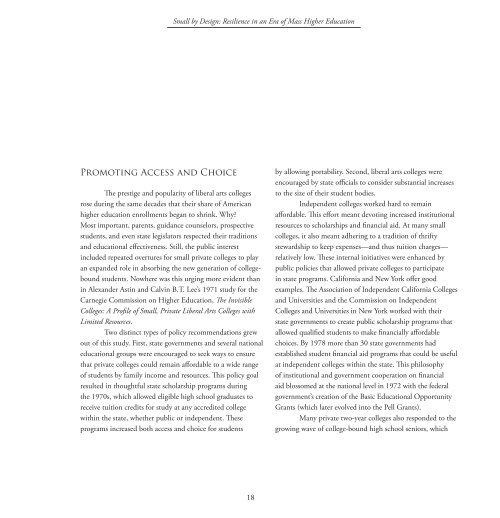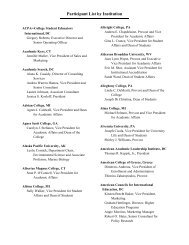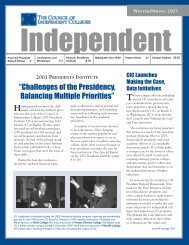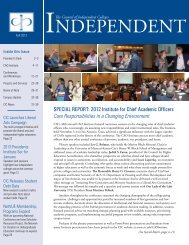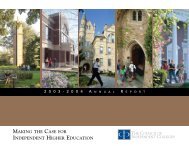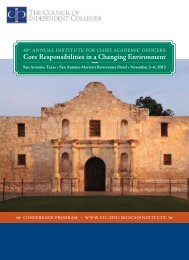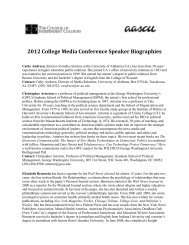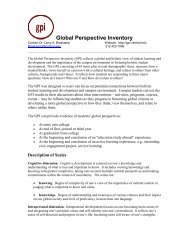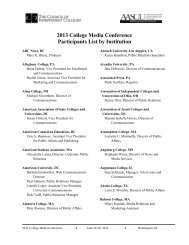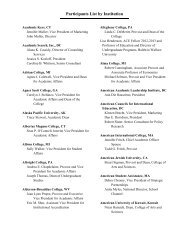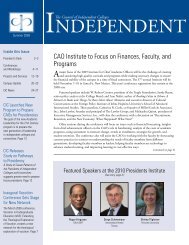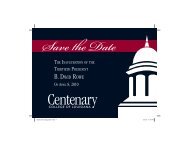Meeting the Challenge: - The Council of Independent Colleges
Meeting the Challenge: - The Council of Independent Colleges
Meeting the Challenge: - The Council of Independent Colleges
You also want an ePaper? Increase the reach of your titles
YUMPU automatically turns print PDFs into web optimized ePapers that Google loves.
Small by Design: Resilience in an Era <strong>of</strong> Mass Higher Education<br />
Promoting Access and Choice<br />
<strong>The</strong> prestige and popularity <strong>of</strong> liberal arts colleges<br />
rose during <strong>the</strong> same decades that <strong>the</strong>ir share <strong>of</strong> American<br />
higher education enrollments began to shrink. Why<br />
Most important, parents, guidance counselors, prospective<br />
students, and even state legislators respected <strong>the</strong>ir traditions<br />
and educational effectiveness. Still, <strong>the</strong> public interest<br />
included repeated overtures for small private colleges to play<br />
an expanded role in absorbing <strong>the</strong> new generation <strong>of</strong> collegebound<br />
students. Nowhere was this urging more evident than<br />
in Alexander Astin and Calvin B.T. Lee’s 1971 study for <strong>the</strong><br />
Carnegie Commission on Higher Education, <strong>The</strong> Invisible<br />
<strong>Colleges</strong>: A Pr<strong>of</strong>ile <strong>of</strong> Small, Private Liberal Arts <strong>Colleges</strong> with<br />
Limited Resources.<br />
Two distinct types <strong>of</strong> policy recommendations grew<br />
out <strong>of</strong> this study. First, state governments and several national<br />
educational groups were encouraged to seek ways to ensure<br />
that private colleges could remain affordable to a wide range<br />
<strong>of</strong> students by family income and resources. This policy goal<br />
resulted in thoughtful state scholarship programs during<br />
<strong>the</strong> 1970s, which allowed eligible high school graduates to<br />
receive tuition credits for study at any accredited college<br />
within <strong>the</strong> state, whe<strong>the</strong>r public or independent. <strong>The</strong>se<br />
programs increased both access and choice for students<br />
by allowing portability. Second, liberal arts colleges were<br />
encouraged by state <strong>of</strong>ficials to consider substantial increases<br />
to <strong>the</strong> size <strong>of</strong> <strong>the</strong>ir student bodies.<br />
<strong>Independent</strong> colleges worked hard to remain<br />
affordable. This effort meant devoting increased institutional<br />
resources to scholarships and financial aid. At many small<br />
colleges, it also meant adhering to a tradition <strong>of</strong> thrifty<br />
stewardship to keep expenses—and thus tuition charges—<br />
relatively low. <strong>The</strong>se internal initiatives were enhanced by<br />
public policies that allowed private colleges to participate<br />
in state programs. California and New York <strong>of</strong>fer good<br />
examples. <strong>The</strong> Association <strong>of</strong> <strong>Independent</strong> California <strong>Colleges</strong><br />
and Universities and <strong>the</strong> Commission on <strong>Independent</strong><br />
<strong>Colleges</strong> and Universities in New York worked with <strong>the</strong>ir<br />
state governments to create public scholarship programs that<br />
allowed qualified students to make financially affordable<br />
choices. By 1978 more than 30 state governments had<br />
established student financial aid programs that could be useful<br />
at independent colleges within <strong>the</strong> state. This philosophy<br />
<strong>of</strong> institutional and government cooperation on financial<br />
aid blossomed at <strong>the</strong> national level in 1972 with <strong>the</strong> federal<br />
government’s creation <strong>of</strong> <strong>the</strong> Basic Educational Opportunity<br />
Grants (which later evolved into <strong>the</strong> Pell Grants).<br />
Many private two-year colleges also responded to <strong>the</strong><br />
growing wave <strong>of</strong> college-bound high school seniors, which<br />
18


